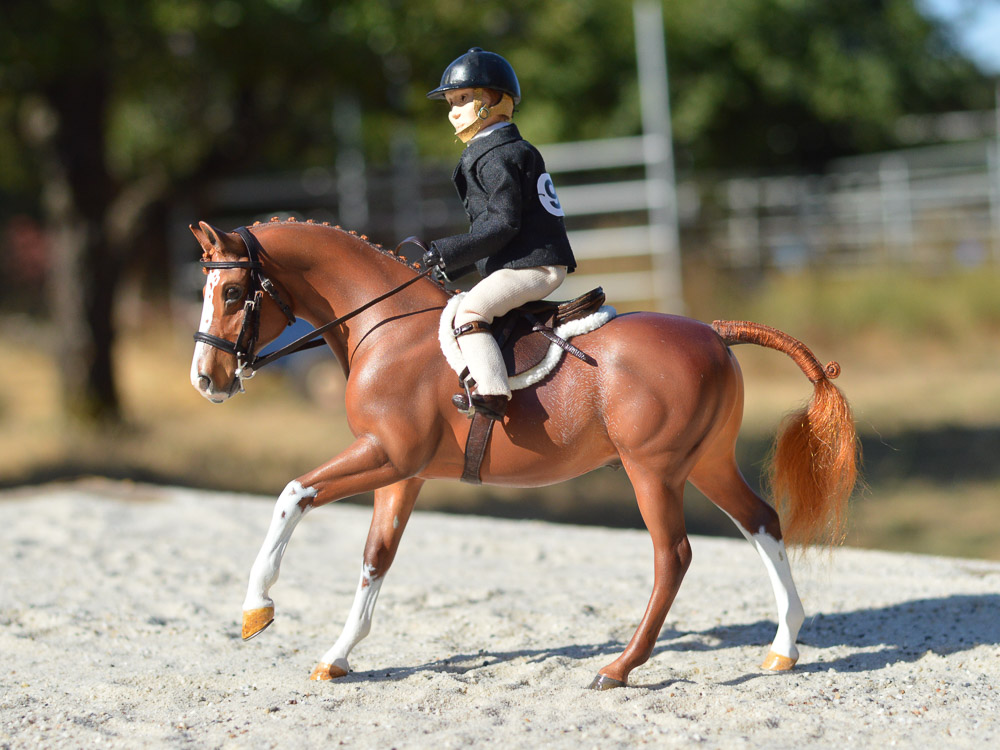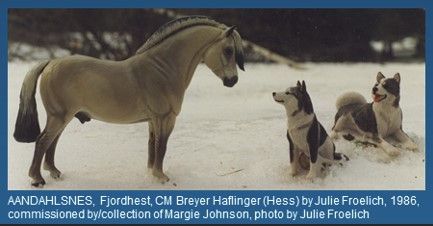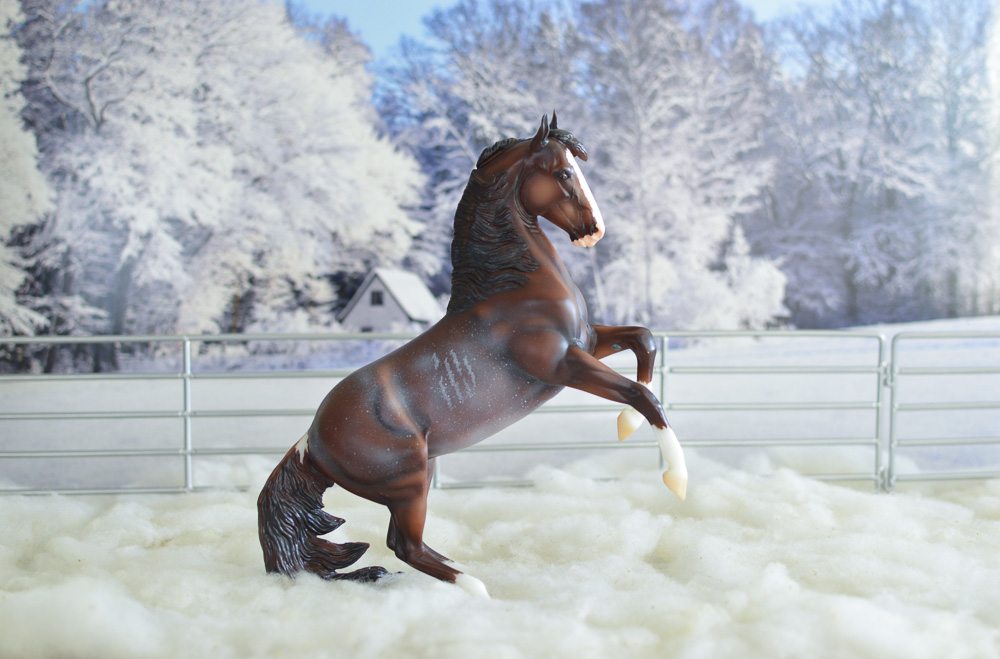Recently there have been a couple of interesting discussions around declaring color when photo showing models. In one case a judge claimed that a shower couldn’t declare a color on an OF plastic model other than what Breyer had declared; in another the judge insisted that a Fjord color designation had to use the Fjord registry specific terms (and curiously, the English translation of those terms, not the original Norwegian).
So here are my questions for discussion:
-
Should we require color next to breed and gender at all? And if so, how specific should that color be? (IE: “chestnut” or “flaxen chestnut sabino rabicano”?)
-
Does it matter to you if a shower chooses a different label for a model’s color than the manufacturer or original artist did?
-
Does it matter to you if the color matches the label that the registry would apply/require? (Chestnut vs sorrel, grulla vs grey dun or grå)
- Should we require color next to breed and gender at all? And if so, how specific should that color be? (IE: “chestnut” or “flaxen chestnut sabino rabicano”?)
- Does it matter to you if a shower chooses a different label for a model’s color than the manufacturer or original artist did?
- Does it matter to you if the color matches the label that the registry would apply/require? (Chestnut vs sorrel, grulla vs grey dun or grå)
I do not mind listing a color, as certain colors can look similar (some sooty chestnuts and silver bays, for instance), so therefore you’re stating what you feel your horse’s color is and potentially justifying a breed designation. Along that line, I also don’t think it matters if you label a horse’s color differently than the manufacturer or even artist had. OF paint jobs do not always look like the color intended/prototype. Also reference pictures get mislabeled so people make incorrect assumptions of colors when they paint them - or science figures out what actually causes a neat color. And there’s definitely going to be a lot more of that as science studies horse colors, if not in actual color, then in patterns. “Hey, turns out that this flashy white marking is actually <fill in the blank new white pattern> instead of just ‘high whites’.”
I think that if we’re going to be labeling colors, we should use the most accurate terminology possible (I say this as I call lighter chestnut stock horses as sorrels, sorry, can’t take the stock horse girl out of me, lol). Therefore, a dun on black should be referred to as either black dun or grulla, rather than grå or grey dun, or some other less-commonly used terminology. And we definitely shouldn’t penalize someone for using the Norwegian grå (grey) instead of the American/English translation of grey dun when referring to a Norwegian Fjord. In this particular show series, I did get penalized for listing Fjords as “bay dun” and “grulla” instead of “brunblakk” [broken brown] and “grå” earlier, and then most recently people got penalized for not using the American terms of “brown dun” and “grey dun.” I guess I don’t mind a judge pointing out that a color is listed as X instead of Y in a certain breed, but I don’t feel that is disqualification-worthy. At most, maybe a reason to decide between two equal horses. Also, if we’re going to go this route, if I list my model horse as “frame overo” or “splash white” instead of the catch-all of “overo” that is usually used by registries to designate not-tobiano, should my model be disqualified in a show?
There’s generally a lot of reasons to not place a model horse, even in very large an competitive shows - angles, lighting, glare, background, overall photo quality. We shouldn’t have to use things like the color terminology or even the “common” (or not-so-common) model name of an entry to disqualify half the horses - just don’t place them if you don’t like them!
Entangled in all of this, as you allude to, is the fact that some designations chosen by registries are … not quite right or confusing. Grey dun to me would mean a horse with the grey-to-white gene on top of some flavor of dun, not dun on black that looks blue or brown grey. ‘Roan’ gets used for extensive sabino like white spotting or sometimes even grey. In Connemaras, especially in the UK and Ireland, the term “dun” is frequently used for a color that is genetically what I would refer to as sooty buckskin - cream on bay with a sooty factor.
- Does it matter to me as a judge or shower what the manufacturer/creator advertised for the horse?
The manufacturers certainly make questionable choices around color (especially in the bad old days) and real talk - we know that there are many horses that phenotypically appear similar despite different genotypical recipes to get there. We know there are chestnuts that pass for palomino and silvers that pass for chestnut and chestnuts that pass for silver and horses that are “obviously” sabino that don’t carry that gene. The only way to be sure for many real horses is to test, and we can’t test the models. If it’s plausible, I’m fine with it, and if it’s questionable, a reference is a good plan.
In addition, factory models often have individual variation that may make the difference in whether their original color designation fits the particular model in question.
I really dislike having to declare a color because as we’ve seen some judges get persnickety about color designations. It gets really hairy with mules because those patterns get WEIRD and I once almost got DQed for misnaming a donkey spotting pattern. I don’t think it really adds anything to require color designations, though I’m aware of a couple shows that do it. If it’s a rare/unusual color then provide some documentation that it exists in the breed.
- Should the color label match the registry’s colors?
This is the one where I was really SMDH - where it was reported that a grulla Fjord was literally disqualified for using the term “grulla.” This is terrible judging. Whether or not “grulla” is your preferred term for the color, or the preferred term for the breed, it is an accurate and well understood term in models. (LOL, back to point 2, it’s the term Breyer used. So you can see these expectations are all in tension with each other.) Similarly, if I were judging a grulla quarter horse and a Norwegian shower had listed it as grå, I’d be fine with understanding that this is a correct term in a different language.
We know that registries have often been antiquated in the color terms they allow, not necessarily including all the possible modifiers and often registering horses as colors that aren’t accurate. True roan isn’t in Thoroughbreds, and some horses with extensive white are in registries that have no way to list those modifiers. Chestnut and sorrel are synonyms and I don’t care if you want to show me your sorrel Thoroughbred even if that’s not a term typically used in that breed.
The only way that color and breed should interact when judging is when the horse has a color simply not found in that breed. The bay tobiano pinto shown as a purebred Friesian is a no. But not because you called him a skewbald. 😉
- Honestly for myself, I don’t love being asked to declare the color. I don’t mind it optional, and references for an unusual color are appropriate, but even as a judge, it’s just not my focus unless you’ve got a breed/color mismatch. I especially sideeye when I am expected to add it for a performance entry.

If I write “Chestnut” is that enough? (Alt: Cantering pony with rider, chestnut, but also sabino and rabicano).
Only when it’s relevant for breed or explaining an OF factory finish as something other than what the model is marketed as is my vote. Only using Breyer marketing designations…yikes. Show me the gene for peppercorn.
Or copenhagen! or, lol, whatever that gene is that Cinnamon has! 😅
The Pinking Shear gene? :P
hahahhahaha
As a judge, I sometimes find myself wondering what color the shower intends the horse to be. That’s usually because the rendering of the color is a little “off” for a valid color for the breed, and slightly closer to something that isn’t. However, it’s not something I weigh heavily. Real colors have a surprising amount of overlap between them - more than many “online color experts” allow - so I give the benefit of the doubt whenever I can.
I also don’t count against entries that have a color misidentified unless it renders the horse unrealistic for its designated breed. If I have them handy, I have been known to put post-its on documentation correcting common misunderstandings, but as long as the model is a reasonably believable version of a legitimate color for the breed it isn’t something that factors in my placings. When it comes down to it, misidentifying your horse’s color is about as real-to-life as it gets. ;)
Unless a host requires something different, I don’t DQ entries unless they are ineligible for the class - wrong breed, wrong scale, etc. Unless the model belongs in another class, nothing is so wrong that I can’t assess the model against what else is on the table.
As a longtime Fjordhest fan, I’m fine with the Norwegian terms, though the use of words that mean “grey” (not greying) and look like English “black” (“blakk” used for dun, “svart” translating for black) are confusing at first. What makes the Fjords trickier is that the grablakk/black dun/grulla has warmer and cooler shades and almost universally does not have a mealy muzzle, while the other more common colors (bay and chestnut dun) are usually mealy. Re OF Breyers, the Fjord offerings on the Astrid mold have been grablakk (premier) and brunblakk (portrait RR), for the Eberl SM, the 2025 set of Stablemates in realistic colors is grablakk.
Using the Region X tag system, I believe you end up with breed and gender on the tag, with any explanation of color on documentation. It’s the unusual colors and partbreds that usually require documentation. My vintage CM Fjord by Julie Froelich is in umber and cream tones, so liver chestnut shade mealy dun, rodblakk. Cherrie Nolden in 2018 cited Cream, Agouti, and Red/Black (Extension) at work in various color inheritance outcomes.

The NFHR (CO, USA) confuses matters by leaving the out the word “dun” with gray in its list of colors on its website: “One of their unique characteristics is that approximately 90% of all Fjord Horses are brown dun in color. The other 10% are either red dun, gray, white or “uls” dun, or yellow dun. The Fjord Horse retains the “wild” dun color of the original horse as well as the primitive markings which include zebra stripes on the legs and a dorsal stripe that runs from the forelock down the neck and back and into the tail. Dark stripes may also be seen over the withers. Red duns have reddish-brown stripes and body markings. Gray duns have black or very dark gray stripes and markings. The white or “uls” dun is a very light body color with black or gray stripe and markings. The yellow dun have a darker yellow stripe and markings, they may have a completely white forelock, mane and tail. The yellow dun is a very rare color in the breed.”
List of colors from Norsk Fjordhest Senter with their translations: brunblakk (brown dun), ulsblakk (uls dun), rødblakk (red dun), gulblakk (yellow dun) og (and) gråblakk (grey dun) — Norsk Fjordhest Senter website (Norsk and their Eng. translation)
Both the US registry and the Norwegian organization omit kvit (double-dilute cream, with the dun factors, white coat with pink skin), which is considered undesirable and may have limitations on registry depending on current rules. This is different from “white” or “uls” dun, which is very pale with mininimized expression of black markings.
A good overview: https://ddungard.com/color-genetics-in-fjords
Personally I don’t think it’s that important unless it’s an unusual color for a breed, or the color (including many “Breyer colors”) can look ambiguous due to the execution of the paint job or how it shows up in a photo. (Not everyone has the skill or resources to properly balance a photo in angle, lighting, color, etc. without using a lot of editing, and most shows these days do not want any more than minimal edits. So, a color description could be helpful to properly present a model for someone who is still skill building for example.)
Might adding a color tag or description be helpful as a matter of accessibility for folks who may have challenges with vision? To my awareness there are some conditions that could impact how well someone can visually distinguish some things and not others, for example. Unless a show site has a sophisticated tool for image captions there may be some things that need to be done as part of the text description in order to make viewing the images more friendly.

